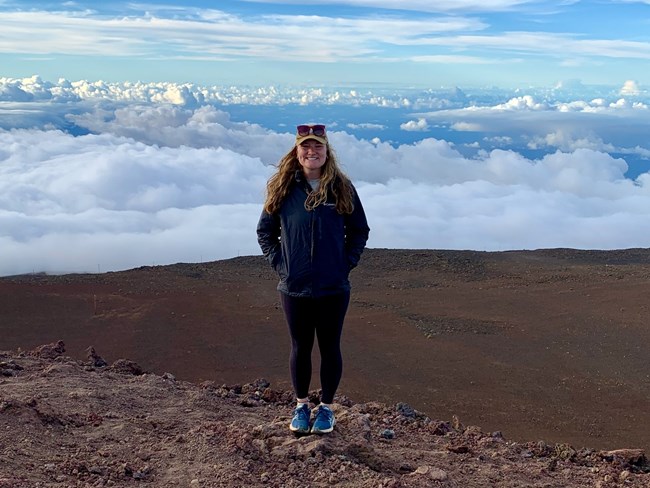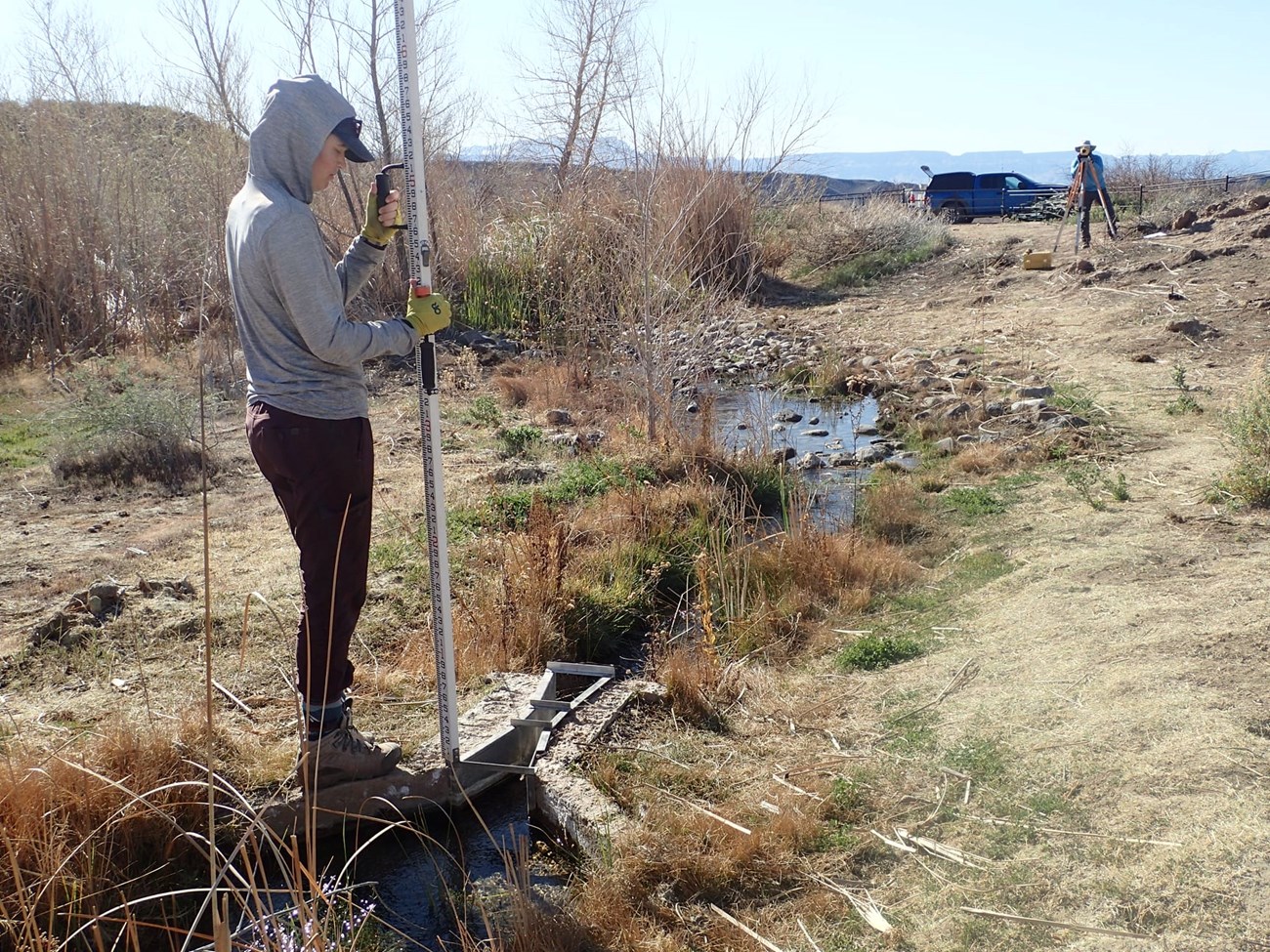Last updated: January 12, 2024
Article
The Oasis Newsletter: Spring 2022


New Project Brief: Desert Springs Monitoring
This winter, we published a project overview brief about desert springs monitoring in the Mojave Desert Network (MOJN). The Network monitors the health of nearly 240 desert springs across five network parks – Death Valley, Joshua Tree, Lake Mead, Mojave, and Parashant.
Springs are natural water sources that form where groundwater reaches the land surface. Compared to the surrounding desert, spring and wetland environments in the Mojave and Great Basin regions support a greater abundance and diversity of plant and animal life.
Given the ecological importance of springs and the threats they face from climate change, drought, and land use impacts, MOJN’s goal is to help inform resource management decisions and strategies by addressing the following monitoring questions:
1. Is water availability at springs changing over time?
2. Is water quality at springs changing over time?
Learn more by reading the brief or visiting our Desert Springs Monitoring web page, where there are links to two videos about this project.
Welcome to New Staff
MOJN recently welcomed four new interns to assist with bats and vegetation monitoring projects this spring and summer. Learn more about their backgrounds and professional and personal interests in the articles below.

Sarah Barsch
Sarah Barsch is our new Great Basin Institute bat technician. She is helping with acoustic bat monitoring, white-nose syndrome surveillance, and also with integrated upland vegetation monitoring. Sarah completed her undergraduate degree in biological sciences at California Polytechnic State University in 2021, with a concentration on wildlife ecology and conservation. Since then, she helped with a study at Lassen Volcanic National Park investigating the impact of plague and climate change on the American pika. She also assisted with wildlife monitoring projects at Crater Lake National Park and is very interested in wildlife disease ecology. When not in the field, Sarah enjoys rock climbing, bread baking, birding, and (in her words) 'drinking copious amounts of coffee.' Welcome Sarah!

Gabriel Elliott
Gabriel (Gabe) Elliott joins MOJN as a Great Basin Institute vegetation technician and is currently assisting with integrated upland vegetation monitoring. He will also help out with spring vegetation, white pine, and aspen monitoring later in the summer. After graduating from Pitzer College with a BA in environmental analysis, Gabe started out working in environmental education and habitat restoration. He worked with Bureau of Land Management and US Geological Survey, researching fire effects on Mojave Desert plant communities. This sparked a passion for native plants, which he brings with him to MOJN. While not at work, Gabe can be found hiking, crocheting, and gardening. We’re happy to have Gabe with us!

Natalie Kim
Natalie Kim is one of our new Conservation Legacy interns and is assisting with integrated upland vegetation monitoring, and as the season progresses, will also help with spring vegetation, white pine, and aspen monitoring. Natalie joins us with a BS in molecular environmental biology from UC Berkeley. Natalie’s background has been ”the bench-side” of plant phenology and genetics research, but she has realized her desire is to pursue field ecology and is excited to monitor desert vegetation communities at MOJN. Outside of work, Natalie is happy to hike, camp, watch k-dramas, and write to pen pals. Welcome Kim!

Ashley O'Brien
Ashley O’Brien is one of our new Conservation Legacy interns. She is assisting with acoustic bat monitoring and white nose syndrome surveillance and is also assisting with integrated upland vegetation monitoring. Ashley completed a BS degree in environmental sciences and biological sciences at Northern Kentucky University. While working as an undergraduate research technician on pollinator habitat restoration, she gained an interest in field work that has led her to various projects, including managing a program employing underserved youth to do ecological restoration in their communities. In her free time, Ashley likes cooking, hiking, rock climbing, and skiing. Thank you for being a part of our team, Ashley!

Scientists’ Training Offered Excellent Learning and Sharing Opportunities
The Inventory & Monitoring Division (IMD) Central Office hosted a Scientists’ Training January 24 - February 17, 2022. IMD scientists designed and led this series of virtual courses to help participants develop skills and learn from peers about work conducted throughout the Inventory and Monitoring Division. The presentations and trainings offered were recorded and are now available to any interested National Park Service staff. Visit the 2022 IMD Scientists Training Sharepoint page for detailed information and links to recordings of the sessions.
These recordings offer valuable information and training for park managers as well as IMD staff, and we encourage park staff to explore them. MOJN Inventory & Monitoring staff both participated as learners and led training or presented in a session.

Sarah Wright, Data Scientist who works with MOJN and several other I&M Networks, was part of the team that led a two-week training on the R programming language for data analysis, visualization, and reporting. Jennifer Bailard, MOJN Physical Scientist, presented a talk in the Cool Tools and Analytics session – Publishing Datasets with the New Data Release Report Template in R Markdown – based on the 2021 publication of the Network’s streams and lakes data package.
The Integrating Science into Management session included presentations and discussions of case studies and lessons learned that emphasized the following (see links to recorded sessions in last paragraph):
- Successful Application of I&M Science in Park Decision Making: Our Science in Action
- Developing and Using Resource Management Decision-making Tools
- Cool Tools and Analytics
There were also several special training sessions that included:
- Climate Smart Conservation and Water Balance
- Intro to R and Advanced R
- GIS training, including Fundamentals & AGOL in NPS, Intro to ArcGIS Pro, and Field Data Collection
For a detailed description of presentations and training sessions, see the Scientist Training Module Descriptions. More specific presentation information is available in this schedule and abstract document. All of the recorded sessions are available on this Microsoft Teams Stream Channel – NPS IMD Scientist Training Recordings. Course websites for both the beginner R course and the advanced R course are available as well.

NPS / Lauren Parry
Fossil Monitoring Program at Tule Springs Fossil Beds National Monument
– Lauren Parry, Park Guide, Tule Springs Fossil Beds National Monument
Desert wetlands and springs are a long-lived feature of the Mojave Desert that are harbingers of climatic and ecological change. The Pleistocene, or Ice Age, sediments of Tule Springs Fossil Beds National Monument (TUSK) capture the cyclic expansion and contraction of desert wetlands over the last ~570,000 years. These wetlands were habitats for a diverse ecosystem of plants and animals, which included now-extinct Columbian mammoths, horses, bison, camels, giant ground sloths, and saber-toothed cats. Although the cause of this extinction is still under scientific investigation, there were many survivors, such as coyotes, jackrabbits, hawks, badgers, and kangaroo rats. Evidence of a wetter past can be found in the fossil snails of TUSK (Figure 1). Fossil snails are documented by monitors to help interpret environments of the past. Today, ram’s horn snails (Planorbella sp.) live in wetlands across the Mojave Desert, grazing on algae.The fossils, sediments, and living plants and animals of TUSK tell a story of change, struggle, and survival from ~100,000 years ago until today.
Scientists use observations of modern spring environments to make conclusions about the Ice Age wetland habitats of TUSK, such as the types of sediment that collect in them, aquatic animals that dwell in them, as well as comparing fossil pollen to living aquatic and riparian plants. Years of analyzing data from the rock and fossil records of Tule Springs have found a strong connection between global climate changes and spring activity. There is one catch: these records of important stories about environmental change are incredibly vulnerable to natural and human-caused threats.

NPS / Lauren Parry
The paleontological site monitoring program at Tule Springs Fossil Beds allows us to monitor previously documented fossil sites for changes in fossil condition, natural erosion, and even human-caused disturbances (Figure 2). Wind, water, and the hot desert sun can erode away at fragile fossils and crumble the soft sediment. Why not collect every single fossil instead? With over 670 known fossil sites, TUSK is the largest open-air Ice Age fossil site in North America. Leaving fossils where they are found is the most practical solution. Depending on the status and condition of different fossil sites, they are given low, medium, and high priority values to help create a realistic and appropriate schedule for how often they should be visited by a site monitor.
Although fossil excavations are rare at TUSK today, this program also helps preserve historic excavation sites from the 1930’s and 60’s that are still intact. These sites are extra vulnerable to vandalism and erosion and are now monitored quarterly by additional volunteer paleontology site stewards. The TUSK paleontological site monitoring program helps to accurately document and preserve fragile and precious fossil resources and the stories they tell for generations to come.
Spring and Summer Field Schedule
| Park | April | May | June | July | Aug | Sept |
| DEVA | Bats1 | Bats2 | Bats2 | – | – | Bat blitz? |
| GRBA | Bats1 | Bats2, Streams & Lakes |
Bats2, Integrated Uplands, White Pine |
Aspen | Selected Large Springs | Streams & Lakes |
| JOTR | Bats1 | Bats2, Spring Vegetation |
Bats2, Selected Large Springs |
– | – | Selected Large Springs |
| LAKE | Bats1 | Bats2 | Bats2, Selected Large Springs |
– | – | Selected Large Springs |
| MANZ | Integrated Uplands | – | – | – | – | – |
| MOJA | Bats1 | Bats2 | Bats2, Selected Large Springs |
– | – | Selected Large Springs |
| PARA | Bats1, Desert Springs, Spring Vegetation |
Bats2 | Bats2, Selected Large Springs |
– | – | Selected Large Springs |
2Acoustics
Farewell to Two Field Staff
Both Emma Kaufman and Evan Kolb, Hydrology Assistants who have been working on our Desert Springs monitoring projects, will be departing soon. We share recent field photos of them and thank them for their great work. Happy Trails to Emma and Evan as they move on to their next adventures.


Newsletter prepared by Linda Mutch and Lise Grace
NPS Mojave Desert Inventory & Monitoring Network
601 Nevada Highway
Boulder City, Nevada 89005
